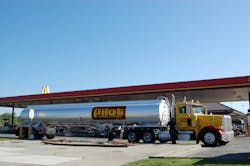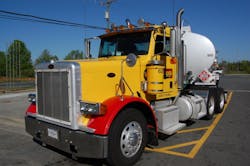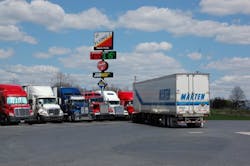Hot off the heels of investing $40 million into its network of 650-plus facilities this year – opening 17 new locations in 2016, with 15 in the U.S. and two in Canada, while adding some 1,300 new parking spaces – truck stop chain Pilot Flying J (PFJ) is planning to spend some $85 million in 2017 on a range of endeavors, which includes the addition of a roadside service fleet and construction of some 20 tire and light maintenance shops.
In a conference call with reporters, Ken Parent, PFJ’s president, said that starting on Jan. 16 though the end of June in 2017, the company will roll out a fleet of 150 already-purchased roadside assistance trucks, predominantly focused on providing tire service and light duty repairs.
PFJ also plans to build 20 maintenance shops “from the ground up” next year as well, with construction to start in late January into the early part of February, Parent noted – part of $85 million PFJ plans to spend in 2017 as part of five year plan to create “a better guest experience,” he said.
“This includes adding more diesel, gasoline and DEF [diesel exhaust fluid] pumps, more showers, more food offerings, and more parking,” Parent explained on the call. “This is a big huge effort. This is a lot from growth perspective.”
Dave Latimer, a longtime truck stop industry veteran who established the Petro Stopping centers network of maintenance shops, will be heading up that effort, Parent added – nothing that Latimer joined PFJ back in July.“We are in the throes of hiring tire technicians right now,” he said. “We are building a network for roadside service [plus] brick and mortar shops. We are really excited about that. We see increased [maintenance] needs out there. Something we’ve not been involved in the past with from tire and light work perspective. We want to make our locations more convenient on the road.”
The $85 million PFJ plans to re-invest into its network in 2017 also includes converting 41 Speedway locations PFJ finished bringing into its truck stop network as part of a joint venture completed back on Nov. 1. “We are converting them over to Flying J or Pilot brand names and should have the initial conversion completed by Dec. 20,” Parent pointed out. “We are investing about $1 million in each: adding DEF pumps, gasoline lanes for four wheel customers, plus showers and restaurants for professional drivers.”
He noted that the company also invested $14 million this year to beef up its WiFi network, he added. “We are providing much more reliability and consistency; not just inside our facilities but out on the lot,” Parent said. “We’re not perfect – far from it – but we’re doing much better job.”
That connectivity will play a critical role in another PFJ project: the launch of a parking reservation system it plans to begin testing in the first quarter of 2017.“We’re going to start testing it out west first with [parking lot] sensors installed in 28 locations,” Parent noted. “Its accuracy is 99% right now; the only issue we have is it does not always recognize when bobtails [tractor units without trailers] are registering for it.”
He added that if the test goes well, PFJ has allocated capital in 2017 to work from the West Coast to the East Coast to “put it in everywhere.”
The reason for that, Parent said is providing drivers with the “real-time availability” of parking spots should help relive a major stress point while making them more productive.
“Parking is a number one issue: the FHWA [Federal Highway Administration] says 75% of professional drivers report problems finding parking spaces,” he pointed out. “With the new stores we added this year, we added 1,300 parking spots. We’re hoping the [real-time reservation] system helps and guides them so they can be more productive, so they are not getting off interstate, running through truck stops with no parking available.”
Parent emphasized that PFJ already offers a parking reservation system, but it’s underutilized to a degree. Currently, he said only 4% of PFJ’s parking spots are reserved out of a total network of 72,000 available spaces.
“We want to also make parking easier for handicapped individual, too, so we will continue to make increased investments,” he added. “We’re working on some things with fleets in certain parts of the country – there’s a lot of activity with customers behind the scenes. It is part of doing everything we can so drivers to have safe place to park.”
Other PFJ initiatives and truck stop trends Parent touched on in his call with reporters included:
- Progress continues on expanding the use of PFJ's smart phone application or “app.” Right now, up to 2% of diesel fuel transactions – over 3,000 per day – are conducted via “cardless” fueling.
- Parent added that some 34,000 PFJ fuel cards are now registered in “mobile wallets.” On top of that, 12% of transactions from PFJ’s large fleet customers are coming through app, with some 90,000 showers reserved through it.
- The company now employs roughly 100 “diesel service champions” who help make entry into and egress from PFJ facilities easier for truck drivers.
- The quest for “healthier food” is gaining traction, Parent noted, with a big uptick in demand for salads through its PJ Fresh stores. “We are selling a lot more of them [salads] versus 18 months ago,” he said.
- New logistical trends are creating “headwinds” for traditional truck stops, Parent pointed out. “We need to stay close to what Amazon is doing each and every day, because when they say they are getting goods closer to the source that means less miles driven,” he said. In some cases that’s creating a “huge need for showers” for relay teams in certain parts of the country. “You can’t take a one-size-fits-all approach anymore,” Parent stressed. “You need to be more regional and locally driven in terms of [the truck stop] amenities you are trying to offer.”
About the Author
Sean Kilcarr
Editor in Chief
Sean Kilcarr is a former longtime FleetOwner senior editor who wrote for the publication from 2000 to 2018. He served as editor-in-chief from 2017 to 2018.


